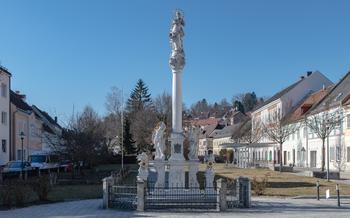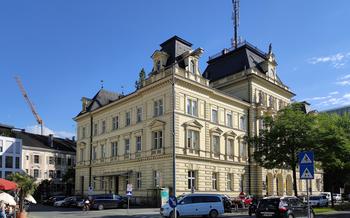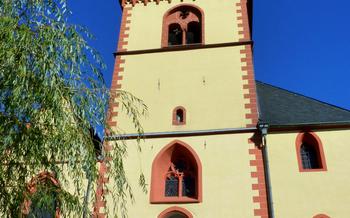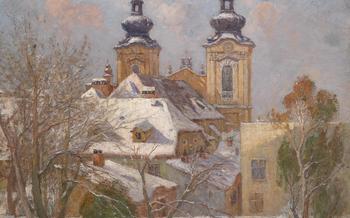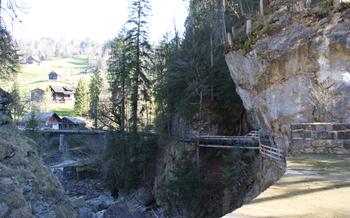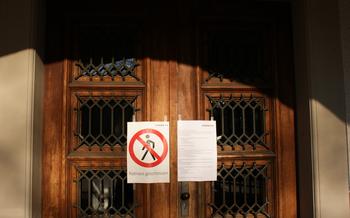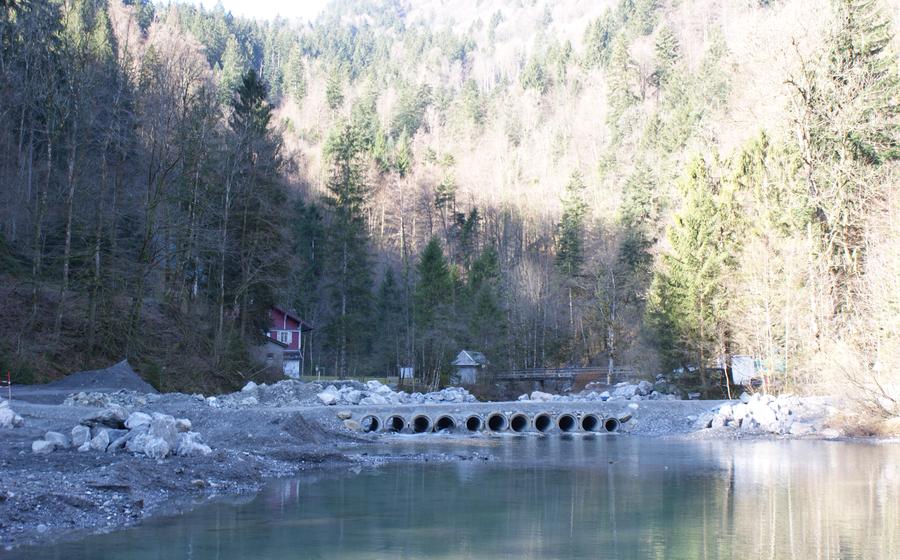
Basilika Rankweil
- History of Basilika Rankweil
- Architectural Highlights
- Religious Significance
- Art and Treasures
- Guided Tours
- Getting There
- Nearby Attractions
- Cultural Events
- Pilgrimage Routes
- Local Cuisine:
- Shopping in Dornbirn
- Accommodation
- Practical Tips:
- Insider Tip: The Hidden Chapel
History of Basilika Rankweil
The Basilika Rankweil, a testament to centuries of faith and devotion, traces its roots back to the 13th century. Initially, a modest chapel stood on this site, serving the spiritual needs of the local community. As the years passed and the population grew, the need for a larger and more substantial church became apparent. In the 15th century, a Gothic-style church replaced the original chapel, reflecting the prevailing architectural style of the era.
The basilica underwent significant renovations and expansions throughout the centuries, each addition and alteration contributing to its unique architectural tapestry. The construction of the late Gothic choir in the 16th century added a touch of elegance and grandeur to the church's interior. The octagonal crossing tower, an iconic feature of the basilica, was completed in the 17th century, adding a distinctive silhouette to the skyline of Rankweil.
Over the centuries, the Basilika Rankweil witnessed numerous historical events and played a pivotal role in the religious and cultural life of the region. It served as a place of worship, pilgrimage, and community gatherings, fostering a deep sense of spirituality and unity among the local population. Today, the basilica stands as a symbol of enduring faith, preserving the rich heritage of Rankweil and attracting visitors from near and far who seek to immerse themselves in its sacred atmosphere.
Architectural Highlights
The Basilika Rankweil stands as a testament to the architectural prowess of its time. Its Gothic style is evident in its intricate ribbed vaults and pointed arches, which create a sense of awe-inspiring grandeur. The interior is adorned with exquisite carvings, sculptures, and stained glass windows that depict biblical scenes and saints. The octagonal crossing tower, a unique feature of the basilica, adds to its visual appeal and serves as a symbol of its architectural significance. The late Gothic choir, with its intricate tracery and delicate ornamentation, is another highlight of the basilica's design. These architectural elements combine to create a harmonious and visually stunning masterpiece that showcases the skill and artistry of the medieval builders.
Religious Significance
The Basilika Rankweil has served as a place of worship and pilgrimage for centuries, attracting devout Catholics from across the region. The basilica is home to the Holy Cross, a revered relic that is believed to date back to the time of Christ. This sacred artifact is enshrined within the basilica and attracts a steady stream of pilgrims seeking spiritual guidance and blessings.
Throughout the year, the basilica hosts various religious ceremonies, festivals, and processions that celebrate the rich Catholic traditions of the region. These events bring together the local community and visitors alike, creating a vibrant and spiritual atmosphere. Easter and Christmas are particularly special times at the basilica, with elaborate ceremonies and processions taking place to commemorate these important holidays.
The basilica's spiritual significance extends beyond its role as a place of worship. It is also a symbol of hope and resilience for the local community. Having withstood the test of time and various challenges, the basilica stands as a testament to the enduring power of faith and the strength of the human spirit.
Art and Treasures
Basilika Rankweil is home to a wealth of valuable artworks and treasures that showcase the artistic and historical significance of the basilica. Among the most notable are the 15th-century frescoes depicting scenes from the life of Christ. These exquisite paintings adorn the walls of the basilica and offer a glimpse into the rich iconography of the Middle Ages. The vivid colors and intricate details of the frescoes bring the biblical stories to life, creating a sense of awe and wonder for visitors.
Other notable artworks in the basilica include the carved wooden pulpit, the stained glass windows, and the ornate altars. The pulpit, crafted with intricate carvings and sculptures, is a masterpiece of medieval craftsmanship. The stained glass windows, with their vibrant hues and intricate patterns, fill the basilica with a kaleidoscope of light, creating a serene and spiritual atmosphere. The altars, adorned with gold leaf and precious stones, are a testament to the wealth and artistry of the basilica's patrons.
These treasures, both large and small, contribute to the overall splendor and significance of Basilika Rankweil. They offer visitors a unique opportunity to admire the artistic and cultural heritage of the Middle Ages and to experience the enduring power of faith and devotion.
Guided Tours
Guided tours are a fantastic way to delve deeper into the history, architecture, and religious significance of the Basilika Rankweil. Knowledgeable and passionate guides bring the basilica's stories to life, offering insights into its past and present.
Regular guided tours are available on specific days and times, catering to individual visitors and small groups. These tours provide a comprehensive overview of the basilica's highlights, including its Gothic architecture, intricate carvings, and valuable artworks.
Group tours are tailored for larger groups, such as school groups or organized tours. Guides can customize the tour to meet the specific interests and needs of the group, ensuring an engaging and educational experience.
Thematic tours are a unique way to explore the basilica's hidden gems and uncover its lesser-known stories. These tours focus on specific aspects, such as the basilica's role in the pilgrimage tradition or the artistic treasures it holds.
Booking a guided tour is recommended to ensure a spot and avoid disappointment. Tours can be booked in advance online or by contacting the basilica directly. Fees may apply, but they are typically reasonable and offer excellent value for the wealth of knowledge and insights gained.
Whether you're a history buff, an art enthusiast, or simply seeking a deeper spiritual connection, a guided tour of the Basilika Rankweil is a rewarding experience that will leave you with lasting memories.
Getting There
Reaching Basilika Rankweil is a breeze, whether you choose public transportation or your own vehicle. For those opting for public transport, hop on bus 50 or 51 and alight at the Basilika stop. The basilica is just a short stroll from there. If you prefer the convenience of your car, there are ample parking spaces available in the nearby car park. Visitors with disabilities can take advantage of the designated accessible parking spaces.
Nearby Attractions
In addition to the Basilika Rankweil, Dornbirn boasts a range of other attractions that visitors can explore before or after their visit to the basilica. Just a short walk away, visitors can immerse themselves in the vibrant art scene at the Kunstraum Dornbirn, showcasing contemporary exhibitions and installations. For those interested in history and culture, the Stadtmuseum Dornbirn offers insights into the town's rich heritage and traditions.
Nature enthusiasts can take a leisurely stroll through the Botanischer Garten Dornbirn, showcasing a diverse collection of plants from around the world. The Rappenlochschlucht, a stunning gorge with cascading waterfalls and lush vegetation, is also worth exploring. For a birds-eye view of the town and its surroundings, visitors can ascend the Karren, a mountain peak accessible by cable car.
To experience regional delicacies, visitors can head to the Markthalle Dornbirn, a vibrant market offering fresh produce, local specialties, and international cuisine. For a unique shopping experience, the Handwerkermarkt Dornbirn showcases the work of local artisans and craftsmen, offering a range of handmade products and souvenirs.
Visitors with limited time can take advantage of combination tickets that offer discounted admission to multiple attractions, including the Basilika Rankweil, the Kunstraum Dornbirn, and the Stadtmuseum Dornbirn.
Cultural Events
The Basilika Rankweil is not only a place of worship but also a vibrant cultural center. Throughout the year, the basilica hosts a variety of cultural events, concerts, and exhibitions that attract visitors from near and far. These events showcase the rich artistic and cultural heritage of the region, offering visitors a chance to experience the basilica in a unique and memorable way.
From classical music concerts to contemporary art exhibitions, the basilica's cultural program is diverse and caters to a wide range of interests. Visitors can enjoy performances by renowned musicians, admire the works of talented local artists, or attend thought-provoking lectures and discussions.
One of the highlights of the basilica's cultural calendar is the annual "Rankweil Festival." This prestigious festival features a series of classical music concerts performed by world-class musicians in the basilica's enchanting setting. The festival attracts music lovers from all over the region and offers a unique opportunity to experience the basilica's acoustics and atmosphere.
Other notable events include the "Rankweil Art Days," which showcase the works of local artists in various mediums, and the "Rankweil Literature Festival," which brings together renowned authors and poets for readings, discussions, and workshops.
For visitors interested in learning more about the basilica's history and architecture, guided tours are available on a regular basis. These tours provide insights into the basilica's construction, design, and religious significance, making them a great way to deepen one's understanding and appreciation of this remarkable landmark.
Pilgrimage Routes
The Basilika Rankweil is a significant stop on various pilgrimage routes, most notably the Way of St. James, also known as the Camino de Santiago. Pilgrims from all over Europe and beyond traverse this ancient network of paths, seeking spiritual enlightenment and a deeper connection with their faith.
The basilica's location along the Way of St. James makes it a popular destination for pilgrims seeking a place of respite and contemplation. Pilgrims can find solace within the basilica's sacred walls, seeking guidance and strength for their journey ahead.
For those embarking on the pilgrimage, the basilica offers a range of facilities and services to cater to their needs. Pilgrims can find accommodation, food, and spiritual guidance at the basilica or in the surrounding area. Local churches and organizations often provide assistance to pilgrims, offering guidance on the route, arranging accommodations, and providing spiritual support.
Local Cuisine:
After a spiritual journey through the Basilika Rankweil, embark on a culinary adventure to savor the delectable flavors of Austrian cuisine. Dornbirn is a haven for food enthusiasts, offering a diverse range of restaurants and cafes that showcase the region's culinary heritage. Indulge in traditional Austrian dishes prepared with fresh, local ingredients, ensuring an authentic gastronomic experience.
For a taste of classic Austrian cuisine, visit Gasthaus Hirschen, a cozy restaurant known for its hearty schnitzel and Käsespätzle (cheese spaetzle). The Gasthof Rose, with its warm ambiance and friendly service, offers a delightful selection of traditional dishes, including tafelspitz (boiled beef) and wiener schnitzel.
If you prefer a more contemporary dining experience, head to Restaurant am Garnmarkt, a stylish eatery that serves innovative interpretations of Austrian cuisine. For a unique culinary journey, try the 7-course tasting menu, which showcases the chef's creativity and passion for local produce.
To satisfy your sweet tooth, visit Konditorei Mangold, a renowned patisserie that has been delighting locals and visitors since 1880. Indulge in their signature Sachertorte, a rich chocolate cake with a layer of apricot jam, or try their delicious Apfelstrudel, a flaky pastry filled with juicy apples and cinnamon.
Dornbirn also hosts several markets and fairs throughout the year, where you can find local specialties, handmade crafts, and fresh produce. Don't miss the weekly farmers' market, held every Saturday in the Marktplatz, where you can purchase fresh fruits, vegetables, cheeses, and meats from local farmers.
Shopping in Dornbirn
For those interested in shopping, Dornbirn offers a variety of opportunities to find unique souvenirs and local products. The city center is home to a charming pedestrian zone lined with boutiques, shops, and galleries showcasing traditional crafts, modern design, and handmade goods. Visitors can find everything from exquisite jewelry and handcrafted ceramics to stylish clothing and accessories.
One of the highlights of Dornbirn's shopping scene is the weekly market held every Friday in the Marktplatz. This vibrant market offers a wide range of fresh produce, regional specialties, and handmade crafts. Visitors can browse stalls selling local cheeses, freshly baked bread, jams and preserves, and unique souvenirs.
For those looking for a more upscale shopping experience, the Messepark Dornbirn is a modern shopping mall located just a short walk from the city center. The mall features over 80 shops, including international brands, fashion boutiques, and specialty stores. Visitors can find everything they need under one roof, from clothing and accessories to electronics, home goods, and gifts.
Accommodation
For those planning to extend their stay in Dornbirn, a range of accommodation options is available to suit various preferences and budgets. From cozy guesthouses and charming bed and breakfasts to modern hotels and luxurious resorts, there's something for every traveler.
If you seek a traditional Austrian experience, consider staying at a guesthouse or a bed and breakfast. These establishments often offer warm hospitality, comfortable rooms, and delicious local cuisine. For a more upscale experience, several hotels in Dornbirn provide amenities such as spa facilities, fitness centers, and panoramic views of the surrounding mountains.
To immerse yourself in the city's vibrant atmosphere, choose a hotel located in the heart of Dornbirn. This will allow you to easily explore the basilica, as well as other attractions, shops, and restaurants within walking distance.
When booking your accommodation, consider factors such as location, amenities, and budget. Online booking platforms and travel agents can help you find the best deals and availability. Remember to book in advance, especially during peak tourist seasons, to secure your preferred choice.
Practical Tips:
To enhance your visit to the Basilika Rankweil, consider these practical tips:
- Timing: Aim to visit during off-peak hours, such as early mornings or late afternoons, to avoid crowds and savor the basilica's serene atmosphere.
- Dress Code: While there is no strict dress code, respectful attire is recommended, as it is a sacred space.
- Photography: Photography is generally allowed inside the basilica, but using a flash is prohibited to preserve the artwork and stained glass windows.
- Accessibility: The basilica is wheelchair accessible, with ramps and elevators available for visitors with disabilities.
- Guided Tours: If you're interested in delving deeper into the basilica's history and significance, consider booking a guided tour. These tours are available in various languages and provide fascinating insights into the basilica's architecture, art, and religious traditions.
Insider Tip: The Hidden Chapel
For those seeking a moment of tranquility and spiritual reflection, venture beyond the main basilica to discover the hidden chapel, known as the "St. Anna Kapelle." Tucked away in the serene surroundings of the basilica's grounds, this intimate chapel offers a unique and peaceful atmosphere. Step inside to admire its simple yet elegant design, featuring a beautiful altar and stained glass windows that cast a warm glow upon the interior. Take a moment to sit in silent contemplation, appreciate the sacred ambiance, and connect with your inner self.


